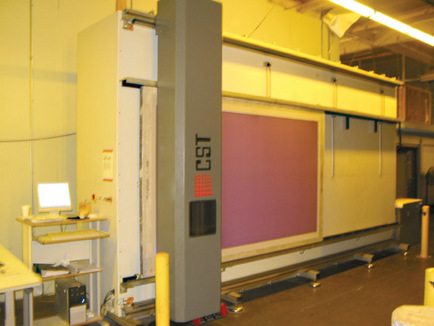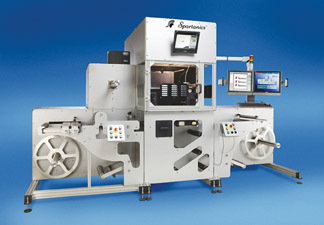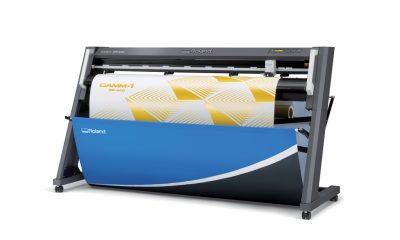Graphics Printing
Published
17 years agoon

Printing grand-format graphics and promotional pieces for the entertainment and transit markets can be very demanding and challenging, especially in southern California, where competition is abundant and high-tech equipment is the norm for most graphics-printing operations. It takes a no-holds-barred way of thinking to compete in a market like that. Read on to discover how Paramount, CAbased Graphic Trends mixed a gung-ho attitude with investments in advanced technology to keep its screen-printing and digital-imaging business several steps ahead of the other players in the area.
Printing grand-format graphics and promotional pieces for the entertainment and transit markets can be very demanding and challenging, especially in southern California, where competition is abundant and high-tech equipment is the norm for most graphics-printing operations. It takes a no-holds-barred way of thinking to compete in a market like that. Read on to discover how Paramount, CAbased Graphic Trends mixed a gung-ho attitude with investments in advanced technology to keep its screen-printing and digital-imaging business several steps ahead of the other players in the area.
A quick entry into screen printing
Kieu Tran, a graphic designer and graphic artist, founded Graphic Trends in 1982. He ran the one-man operation, which offered a variety of graphic-design services exclusively, until one day his best customer walked into the shop and asked Kieu if he could screen print signage. “Sure!” Kieu replied. And with a can-do spirit—but no screen-printing equipment on hand—Kieu immediately went out and purchased his first press, an M&M single-color clamshell. He then had to hire someone to help him screen print the signage. Kieu and his company were officially in the business of screen printing.
One year later, the two-man operation moved into a 1500-sq-ft building located across the street from Kieu’s home. Graphic Trends continued to grow, expanding its list of clients, job orders, and staff to support the increase in work. In 1993, the company moved into a 12,000-sq-ft facility and added an American Husky 52 x 80-in. press and a gas dryer. A few years later, Graphic Trends added 60-in. x 23-ft and 60-in. x 18-ft UV dryers. The company beefed up its prepress operations with the addition of a Sefar 92 x 160-in. screen stretcher in 1999.
By 2000, Graphic Trends had grown to a staff of 40 employees with an equipment line that included two M&M single-color presses, an American Husky press, a Sakurai 33 x 44-in. press, an M&R long-stroke, and three M&R Patriots. Later that year, Graphic Trends added an M&R five-color inline system, an OYO Liberator XR 5400, and more space to its facility, which brought the building size to 20,500 sq ft.
The following year, the company purchased an M&R Conquest six-color press, an Epson Stylus Pro 9600 proofing system, and another OYO Liberator XE 5400. But within two years, Graphic Trends sold the M&R carousel and bought a Thieme 5070 five-color, large format (62 x 103-in.) inline press. In 2004, the company welcomed its first piece of digital equipment, a NUR Tempo flatbed inkjet printer. Graphic Trends also made a major transition in its prepress processes with the implementation of a CST DLE directto- screen system. Last year, the company added its second DLE system and expanded its prepress department with an Epson Stylus Pro 9800 and a Grunig automatic screen coater. Graphic Trends also grew its family of digital printers with the addition of a VUTEk 5330 printer from EFI. Today, the 60-employee outfit specializes in printing a variety of graphics, such as banners, window clings, bus/ transit shelter graphics, P-O-P signage, and more, for an array of clients in the fast-food, retail, movie, and automotive industries.
Where it all happens
Graphic Trends’ prepress department is a top priority when it comes to investing in advanced technologies. The prepress area houses six employees, four Mac G5 stations, Epson 9800 and Epson 9600 proofing devices, and an OYO thermal imagesetting device. The staff uses the Epsons to output proofs for customers and perform color-correction work for production. The OYO serves primarily as a backup system for the company’s direct-to-screen equipment (Figure 1).
“We were the first CST direct-toscreen owners in the US, and we were the first company to purchase two CST systems in the US,” says Allen Gasper, production manager. “We are 99% direct to screen now. It was a huge transition and really has added a great deal of consistency, efficiency, and cost competitiveness in our industry. That has been a very vital and big change to our workflow and prepress environment.”
The prepress staff uses ProfileMaker5 to build, create, and edit color profiles for different inks and substrate combinations. They create the company’s ICC profiles in house (Figure 2), in addition to handling linearization and calibration functions for the prepress and printing equipment. Harlequin, ColorBurst, and Wasatch are the shop’s RIP software programs of choice.
In the screenmaking area (Figure 3), you’ll find an 86 x 160-in. Grunig automatic screen-coating system, a 92 x 160- in. Sefar screen stretcher, and 92 x 180- in. Douthitt vacuum frame. The company rarely uses its traditional screenmaking equipment and only keeps it for the sake of redundancy. In fact, Graphic Trends may get rid of its vacuum frame system because of the large amount of space it takes up in the screenmaking area.
The production department is home to a staff of 20 and several largeformat printing devices, including inline and single-color screen presses (Figure 4) and inkjets (Figure 5). UV dryers and a 120-in. Thieme TSC 310 squeegee cutter round out the equipment in that area. The production floor is always bustling, and when the jobs stack up, it’s not uncommon for Graphic Trends to run two 12-hour shifts in this department. On any given day, you’ll see the presses churning out graphics in a range of sizes and on a wide assortment of substrates. Examples of typical jobs include 5 x 8-ft, two-sided banners, 10 x 15-ft banners, 14 x 48-ft billboards, 50 x 71-in. graphics for bus shelters, 40 x 60-in. banners, and static-cling and paper signage for retail stores (Figure 6). 0 1 2
Graphic Trends’ inline presses play a critical role in supporting the volume of job orders the company receives, the size of the jobs, and the immediate turnaround times. Gasper explains that in the P-O-P market, especially in the shop’s part of the country, the demand for screen printers to offer impressive turnaround times and high-quality graphics is considerably different from the pressure put on printers in other parts of the US. Clients in southern California insist on press checks—not a few times per month, but anywhere from two to eight times in one day.
“The only way to achieve that in an efficient manner and to meet the tight deadlines that we have to adhere to is to have the sophistication of an inline machine,” Gasper says. “You won’t survive in the southern California environment without it.”
Why do clients in that market make such demands? Because they know there are many other printers in the area who can deliver their job by the next day. “The days of a small shop slowly growing into a medium-size shop, which then slowly grows into a large shop are over in southern California,” Gasper says. “You have to make the multi-million dollar investment in inline technology. Take the risk that you can get the work, or you won’t survive.”
A majority of the work that comes into Graphic Trends is for local clients, which allows the company to deliver jobs the same day. That’s a plus. The downside is that clients know that Graphic Trends’ competitors also can fulfill orders within the same time frame. “I have to be willing to exceed or at least meet their demand. It demands the latest technology without sacrifice,” Gasper says.
So how does a screen-printing shop in such a relentless buyers’ market differentiate itself from the competition? “I’m constantly striving for ways to separate us from the pack with technology and efficiency,” Gasper says. “The inline was the foundation of just putting on the uniform, so to speak, to play ball…. Buying the inline press just makes you part of the ball team. But you are no better or worse than the other players out on the field.”
Graphic Trends has found that its Thieme inline press is especially suitable for printing on rigid substrates, such as card stock and styrene, and pressure-sensitive applications for the transit industry. Determining which substrates to use for a given job is a fairly simple task for the folks at Graphic Trends, as the shop has standardized the process. The staff knows exactly what its customers expect in terms of which substrate should be used for a particular job. The only challenge Graphic Trends faces in this area is researching media to find the substrate that meets customer demand and runs very well on press without sacrificing quality.
Graphic Trends also offers finishing and fulfillment services. The finishing department has access to two Rosenthal 72-in. sheeters, a Seybold 85-in. cutter, six industrial sewing machines, three automatic grommeting machines, a round corner machine, a Leister Uniplan hot welding machine, and a few miter and table saws. The packaging and fulfillment area includes a custom labeling system, an automatic box-banding machine, a shrink-wrap machine, and more.
Graphic Trends’ customers come mainly from the litho and offset industries. Being a for-trade printer, Graphic Trends actually prints jobs for other printers and rarely deals with the end customer. That also means the shop must be at least as detail oriented as its customers are. “They know their business, we know ours,” Gasper says. “There is no selling around what we do that you could get away with in another market.”
Here’s an example. When a customer prints 80% of a job order and hires Graphic Trends to print the remaining 20%, all graphics must match. It’s this kind of situation that makes the staff at Graphic Trends realize just how critical it is to have a color-profile system in place. “It is something we constantly work on. Not a day goes by here that something in that nature has not been improved upon in one form or another,” Gasper says.
Doing whatever it takes
The foundation of success and continual growth at Graphic Trends is set in the company’s business philosophy of doing whatever it takes to get the job done, getting it done on time, and making sure that the job is produced as accurately as possible. Realizing these goals may require working late nights, on the weekends, and even on some holidays. The staff at Graphic Trends constantly received rush orders, and they know that they must be flexible in order to turn the work around immediately.
It’s not uncommon for Tran or Gasper to send a prepress employee home at noon and ask him or her to return later that same evening because a client isn’t able to deliver a file for a job until that time. Trend and his staff realize that their drive to accommodate clients has earned the company the reputation of being a shop that will get the job done and not turn away work because of late files.
“A relationship builds up, and rather than being seen as the digital or screen printer to call in emergency situations, appreciation builds up between Graphic Trends and its clients,” Gasper says. “Our customers tell other customers, ‘Take your work to Graphic Trends. They helped us half a dozen times when other printers refused to do the job.’”
The management team at Graphic Trends recognizes its employees’ ambition, drive, and willingness to do whatever it takes to get the job done and on time. Many employees have been with Graphic Trends for years, and management continually searches for ways to make the work environment as inviting and accommodating as possible for its loyal workforce. The company also explores ways to improve health and medical benefits, review processes, pay scales, and 401k plans.
Looking ahead
Graphic Trends has made major investments and purchases in equipment in the past three years to improve the efficiency and quality of its prepress processes and offer grand-format-printing capabilities to satisfy the needs of its growing list of clients. Given the competitive climate in which the shop works, Graphic Trends must continue to investigate the technologies and processes that foster what Gasper calls a one-stop-shop atmosphere.
Graphic Trends recognizes the value of employing both screen- and digital printing and the importance of the two technologies working hand in hand. As Gasper puts it, “Any screenprinting shop, to stay successful in this industry, has to embrace digital. Without a doubt, I don’t believe—as I did not believe ten years ago—that digital will wipe out screen-printing technology. But without a doubt, you need the clairvoyance to see that digital is the future. It certainly has its limitations…but in one form or another, be it for printing prototypes, used in the production department, or just to encapsulate a one-stop-shop atmosphere, even at cost to ensure that your customer doesn’t go to a competitor, digital technology has to be embraced. It is mandatory.”

Subscribe

Magazine
Get the most important news
and business ideas from Screenprinting Magazine.
Most Popular
-

 Case Studies2 months ago
Case Studies2 months agoHigh-Density Inks Help Specialty Printing Take Center Stage
-

 Art, Ad, or Alchemy2 months ago
Art, Ad, or Alchemy2 months agoF&I Printing Is Everywhere!
-

 Andy MacDougall2 months ago
Andy MacDougall2 months agoFunctional and Industrial Printing is EVERYWHERE!
-

 Columns3 weeks ago
Columns3 weeks ago8 Marketing Mistakes Not to Make When Promoting Your Screen Printing Services Online
-

 Editor's Note3 weeks ago
Editor's Note3 weeks agoLivin’ the High Life
-

 Marshall Atkinson3 weeks ago
Marshall Atkinson3 weeks agoHow to Create a Winning Culture in Your Screen-Printing Business
-

 Thomas Trimingham2 months ago
Thomas Trimingham2 months ago“Magic” Marketing for Screen Printing Shops
-

 News & Trends2 months ago
News & Trends2 months agoWhat Are ZALPHAS and How Can You Serve Them in Your Print Business?






